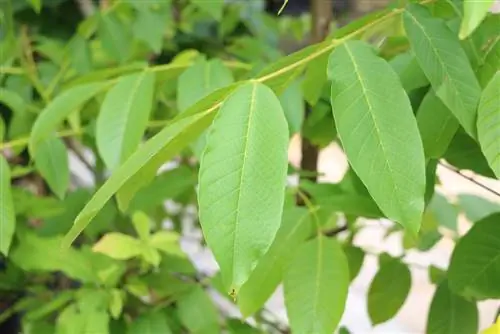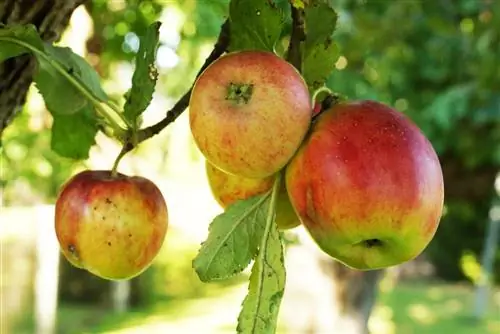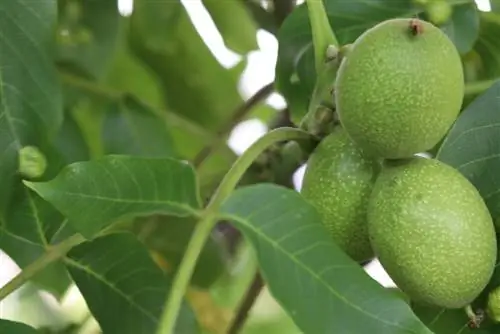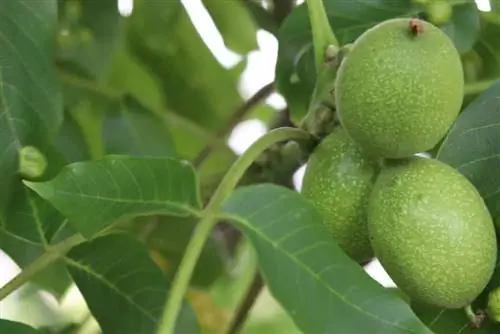- Author admin [email protected].
- Public 2023-12-17 03:39.
- Last modified 2025-01-24 12:45.
The walnut tree is one of the oldest known tree species. Almost all parts as well as the nuts are the purest garden pharmacy. In addition, its tannin-rich leaves can keep unwanted insects away. For most people, however, the nuts are the main argument for planting a walnut tree. When it comes to height, a distinction is made between tall and short varieties. But how powerful can such a tree actually become?
Growth heights of walnut trees
The real walnut (Juglans regia) is a deciduous, sprawling and fast-growing tree. Over the course of its life, under favorable conditions, it can reach stately dimensions, both in height and width of the crown.
- Walnut can reach heights of 25-30 m
- Stem develops depending on the variety, diameter of up to 200 cm
- The broad, round crown can reach dimensions between 10 and 15 m
- Walnut tree develops deep taproots
- Root system is also significantly wider
- The dimensions of the root can exceed those of the crown
If you want to plant a walnut tree, you should plan an area of 70 to 120 m2 depending on the variety, even if it appears relatively slender at first. There are now also varieties that are significantly smaller in growth and are therefore suitable for smaller gardens and sometimes even for larger pots.
Dwarf varieties significantly smaller

In contrast to the usual stately walnut trees with their imposing shape, dwarf varieties grow slower and more compactly. They remain significantly smaller and their crown is less pronounced. So you don't have to go without walnuts even if you don't have much space. When fully grown, small varieties usually do not grow taller than 400-600 cm and reach a crown diameter of 200-400 cm. Nevertheless, these trees also bear fruit because they are generally self-pollinating.
Tip:
Good small-growing varieties include the Weinsberg walnut, the bush nut from Finkenwerder and the varieties Lara, Europa, Dwarf Karlik(R) and Mini Multiflora No. 14.
Average growth per year
- Noticeable differences between seedling plants and cultivated varieties
- Growth slower from seedlings grown from nuts
- Only slight growth noticeable in the first and second years
- From the third year onwards, the growth rate increases significantly
- Now between one and two meters per year
- Growth speed of cultivated varieties, depending on the respective variety
- Early and heavy-bearing ones grow rather slowly
- Others have an annual growth rate of between 50 and 100 cm
- Largest growth occurs between the 10th and 30th year
- During this time the walnut tree grows fastest
Later, growth slows down again and focuses primarily on the width of the crown and the development of the fruits. From around the 40th year onwards, crown growth decreases again. At around 70 to 80 years of age, height growth is complete. As a rule, the yields then also decrease somewhat. For short or dwarf varieties, the annual growth rate is between 10 and 20 cm.
Tip:
A walnut tree grown as a seedling bears fruit for the first time after 10-15 years at the earliest, while cultivated varieties only bear fruit after four to six years.
Factors affecting growth

How tall a walnut tree can ultimately grow depends on various factors. The variety and age of the tree as well as the trunk circumference, the soil conditions and the stand density can have a positive or negative influence on the growth behavior of the walnut tree.
Variety-dependent growth heights
How big a walnut tree ultimately becomes and how long it takes can vary greatly from variety to variety. There are small varieties such as the 'Chatenay Nut' with a height of up to four meters and medium-tall walnut varieties such as Juglans regia 'Weinsberg 1', which can reach heights of around seven meters. Both are well suited for smaller areas in the garden. In contrast, there are medium-growing specimens such as the 'Red Danube Nut', which grows up to 12 m in height, and strong-growing ones such as the early-sprouting Kurmarker Walnut (No.1247) with sizes between 15 and 25 m.
Age of the tree
- Age of the tree has a significant influence on growth
- Growth rather irregular and slow in the first few years
- Growth usually not even 20 cm per year
- Is usually even far lower
- In the following years he easily gained between one and two meters
- Growth more even and constant from the 10th year onwards
- Now grows between 50 and 100 cm per year
- Tree has reached its maximum height and width at around 80 years old
Trunk circumference
The respective trunk diameter also has an influence on the growth of these trees. Responsible for this are the so-called vascular bundles, which run in the bark and supply the tree with water and nutrients through the capillary effect. The more space these vascular bundles have, the better the tree is supplied, which in turn promotes growth in height and width. In older specimens, from a height of around 25 m, this capillary effect is usually no longer sufficient, growth stagnates and the tree has reached its maximum size.
Consistency of the soil
Another factor that influences growth is the condition of the soil. For example, if the tree is on poorly ventilated soil that is prone to waterlogging or is too sandy, this can certainly affect its growth. It grows more slowly and fruit production also suffers. On the other hand, a calcareous loam or clay soil can contribute to optimal growth conditions and yields. In general, the walnut tree feels most comfortable on acidic to neutral soils. Soils with an alkaline pH value are also tolerated.
Inventory density

The height that this tree can reach also depends on whether it stands alone or in a stand of several trees. Single specimens usually do not grow higher than 20 m, while trees in the middle of a dense stand can grow up to 30 m high. This is because in denser stands they literally push their way up towards the light and can therefore grow larger. However, this only affects the height growth and not the width growth of the crown, which is usually smaller.
Special features when editing
Pruning the walnut is actually only necessary when it has grown too much and takes up too much space. The aim of pruning measures should always be to maintain the species-typical shape of the tree. The most important thing is the right cutting time. It's in late summer orAugust September. During these two months the sap flow is very weak because the tree is preparing for winter rest. In addition, the cuts can heal before winter, at least the smaller ones. If this point has been missed, for whatever reason, winter pruning is still possible from mid-December to mid-January. This late cut has the advantage that the walnut no longer bleeds because the sap flow has stopped.
Lighten out or shorten?
The walnut tree reacts to the shortening of individual side shoots with stronger shoots. If you don't want that, it's better to make a thinning cut. This gives the tree the opportunity to build up a loose crown over the next few years. If the crown is too thick or too expansive, a thinning cut is usually not sufficient, so the outer shoots have to be shortened.
- When thinning out, cut out some crown branches up to the trunk
- To reduce the diameter of the crown, shorten the shoots
- In the first year, cut back every second shoot
- Up to the height of a fork, by a maximum of 150 cm
- Next year, cut back the remaining shoots
- Also remove diseased and dead wood
- Avoid pruning measures in early spring
- Sap flow is strongest at this time
- Tree would be weakened but not die






